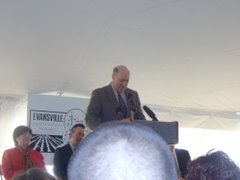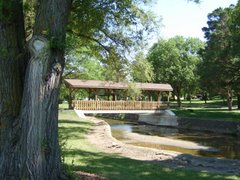(Ed.note: This is a portion of the minutes of the Evansville Common Council Committee Meeting of the Whole from last Saturday, April 5, 2008)
C. Wastewater Treatment Facility.
Sauer said that the City’s wastewater treatment facility (WWTF) had been built in 1982, designed to last for 20 years with a capacity of 600,000 gallons per day. We are currently around 80% of capacity, but nitrate and chloride concentrations above state standards are driving the need for upgrades to the WWTF. The facility planning process has been started; construction may start in late 2008 or 2009 and be completed in 2010.
The least expensive option would add insulated covers to the lagoons and install a moving bed reactor for around $1.85 million. This may meet the City’s needs for the next 5 to 10 years but would not allow for future expansion.
The other options would involve constructing a mechanical plant with aerobic digester for around $2.25 million. In addition to addressing the current treatment needs, this would increase the WWTF’s capacity and meet the City’s needs for the next 20 years. The design would allow for future expansion when needed. The mechanical plant would also have lower operating costs.
The possibility of a mechanical plant with anaerobic digester was discussed. This type of infrastructure is very expensive and not cost effective for a city of Evansville’s size. However, it could be an attractive option with grant money to offset the capital costs.
The Committee agreed that the most cost effective option in the long run would be a mechanical plant and indicated this should be included in the facility planning. Noting that 50-60% of the WWTF operating costs are energy, the Committee indicated that any opportunities for energy conservation should be explored for the new facility.
Tuesday, April 08, 2008
Subscribe to:
Post Comments (Atom)






























A few years ago, when the Smart Growth Plan was developed, the sewer plant was at around 60% capacity, and David Sauer opined that rapid residential growth would not suck up much of the remaining 40% capacity. I understand the nitrite and chloride issue might be new and not anticipated at the time the Smart Growth Plan was developed. But David Sauer did not warn us that we were on the verge of going from 60% to 80% capacity in a few years. I am quite certain of that.
ReplyDeleteBill Connors
Former Evansville City Administrator